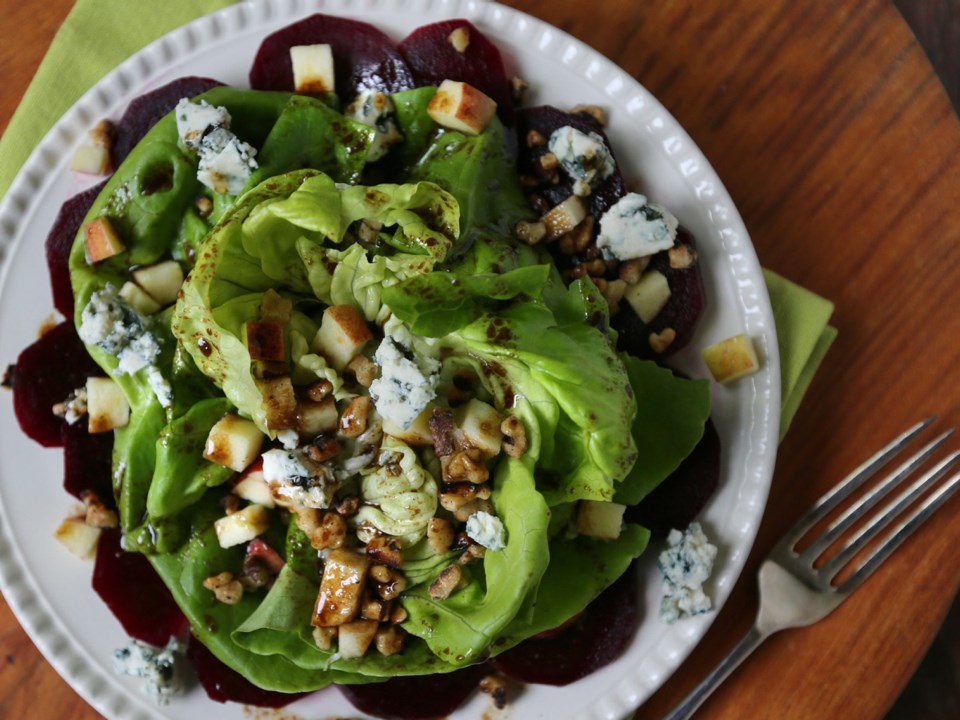Dear Eric: Why do beets — and some other vegetables — sometimes taste like dirt? Pat
Dear Pat: The beet is sometimes classed as being like cilantro in that people seem to either love it or loathe it. Human instinct seems to be a deciding factor in how one feels about either of them.
With regard to cilantro, there’s no shortage of folks around the world who will happily pile, swirl or toss multiple sprigs of it into or onto a soup, salad, stir-fry or other creation. On the flipside, there’s also no shortage of people who won’t go near cilantro because they can’t get past its perceived soapy taste and aroma.
One person who loathed cilantro was the late and great culinary icon Julia Child. In a 2002 interview with CNN’s Larry King, Child said if she saw it in a dish she would pick it out and throw it on the floor.
According to a New York Times article by Harold McGee titled Cilantro Haters, It’s Not Your Fault, he writes that some studies have suggested people might be genetically predisposed to dislike cilantro. Another opinion on the topic suggests it could simply be a case of humans showcasing the primal importance of how our sense of smell and taste have helped us survive. If a food does not smell or taste good to us, or natural reaction is to spit it out or not to eat it.
With regard to beets, the reason some people have trouble gulping them down is because they think they taste like dirt. Beet lovers, on the other hand, describe that taste as being earthy and one they find most appealing.
Beets grow in dirt and I assumed that’s why they might taste of it, even after being washed. But not so according to an article by Irwin Goldman published in Wisconsin’s Magazine for the Life Sciences.
In that story, this beet breeder and professor of horticulture at the University of Wisconsin says it’s not the soil that gives beets their earthy — some would say dirt-like — flavour, it’s the geosmin. Goldman says geosmin is an organic compound produced by microbes in the soil that gives off a smell like freshly plowed earth or a field after a rainstorm.
As soon as I read that, I remembered that when I lived in Saskatchewan when it rained after a summer dry spell, the earth would have the most incredible aroma. In my mind, I can still smell it now.
According to Goldman’s article, that’s not surprising. He says human noses are very sensitive to geosmin, with some people enjoying it, while others will literally put their noses up when they detect it.
Pat, it sounds as if you are one of those folks who are acutely aware when geosmin is present. Beyond beets, other foods high in it include lettuce, mushrooms and spinach.
According to several sources, geosmin is also responsible for the muddy smell in bottom-dwelling freshwater fish, such as catfish.
Geosmin is not toxic or harmful, so, Pat, if you can get past them sometimes tasting like dirt, you won’t miss out on their nutritious benefits. Beets are low in calories and contain vitamins A, B and C, beta-carotene, folic acid and many minerals, such as potassium and iron.
Beets, of course, can also be used to make some tasty and eye-appealing dishes. These include soups, preserves and salads, such as today’s recipe that sees beets and butter lettuce get all dressed up.
Beet and Butter Lettuce Salad with Blue Cheese, Apples and Walnuts
Earthy beets, tender lettuce, tangy cheese, crisp apple and rich nuts combine in this salad. It would make a nice lunch or light supper when served with some crusty bread.
Preparation time: 25 minutes
Cooking time: About 35 minutes
Makes: 4 servings
2 Tbsp balsamic vinegar
1 tsp Dijon mustard
1 tsp honey
5 Tbsp olive oil
• salt and freshly ground black pepper to taste
8 small to medium beets, washed well (about 1 1/2 lbs.)
1/3 cup chopped walnuts
1 head butter lettuce, cored and separated into individual leaves
1/2 small to medium red apple, cut into small cubes
125 grams blue cheese, pulled or crumbled into small nuggets
Make the salad dressing by placing the first five ingredients in a small jar. Put the lid on the jar and shake it to blend the dressing. Refrigerate salad dressing until needed.
Place the beets in a pot and cover with about four inches of cold water. Set over medium-high heat and bring to a boil. Reduce the heat until the water is gently simmering. Simmer the beets until tender, about 30 minutes.
When cooked, drain the beets well. Fill the pot with ice-cold water to cool the beets. When cooled, drain the water away and then peel each beet. Thinly slice each beet and place the slices in a bowl. Cover and refrigerate beet slices until ready to serve the salad.
When ready to serve the salad, place a skillet over medium heat. When hot, add the walnuts to the pan and cook and stir until they are lightly toasted, about two to three minutes. Remove the walnuts from the heat.
Divide and set a ring of beet slices on the outer edge of each of four plates. Divide and mound butter lettuce in the centre of each plate, tearing the larger leaves into smaller pieces as needed. Divide and top the lettuce and beets with the apples, walnuts and cheese. Drizzle each salad with some of the salad dressing and serve.
Eric Akis is the author of the hardcover book Everyone Can Cook Everything. His columns appear in the Life section Wednesday and Sunday. Send questions by email to eakis@timescolonist.com



